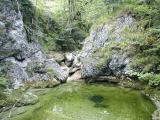First Metal Detecting Finds (4/6)
First finds at crossroad area
Four hours later my finds comprised just two projectiles. Not very impressive.
The one on the right is a hunter’s bullet from the late 19. century. At least the .45 pistol projectile on the left can possibly originate from WW II. Maybe, maybe not. After the promising foxholes these finds were a bit disappointing. I climbed down to my car and felt very exhausted. While I did not want any more detecting that day I decided to have a visual inspection of the creek that passed by the crossroad. If I would be a soldier standing at the junction on May 7, 1945, I might have discarded some equipment into the creek. Streams, lakes, and ponds were always very attractive for this purpose. No need to dig.
Creek picture 1
The creek turned out to be a lovely mountain stream. Though this picture was taken just 30 m / 33 yards from the crossing the area looked natural and I noticed hardly any junk.
Creek picture 2
There were even natural pools inviting the tired treasure hunter to relax a bit on a hot summer day.
What a charming environment! I climbed here and there and almost forget why I came here. Then I found this:
The Panzerfaust
It was the launching tube of a Panzerfaust, a light German WW II anti tank weapon. And it lay open on the gravel for everyone to see. Was it possible that I was the first person to visit that place since the end of WW II? That seemed highly unlikely but the find was there.
Panzerfaust Detail
Here the front part in greater detail
I was delighted. After a somewhat mediocre beginning the day had produced a WW II relic. I was doubtless up to something. The find itself is not more than a steel tube with some fittings but it had a military and historical meaning. When I examined it closer I found that it was not empty. It was difficult to look inside but there was something like a black mass. It did not look like dirt or leaves. Hmm. I had never found such an item before but I knew that the propulsion charge can be very dangerous, even more dangerous than the missing warhead.. When fired it created a flame 4 to 5 meters (some 5 yards) long.. For that reason firing from within a house was dangerous. The soldier was in danger to burn his own back.
Since I felt a healthy respect for all sorts of live ordnance I decided to leave the item where it was and to do a bit of research on these weapons and their dangers. Certainly I did not want to blow myself up when trying to clean it. That was on a Monday.
The Panzerfaust came in various types. Panzerfaust 30, 60, 100, and 200. The type number indicates the firing range in meters. The earliest models had a range of just 30 meters/33 yards. Must have been quite a fearful experience to approach a tank that close. The most common type at war’s end was the Panzerfaust 100.
Equipped with more knowledge, some tools, and my detector I returned four days later on Friday to avoid the weekend wanderers. Guess what? The tube had disappeared!. Somebody took it. What a coincidence. It lay there possibly for decades and nobody cared. Now within a few days it was discovered by two independent persons. Well, I hope the other guy knows how to handle it.
Since I had no opportunity to measure the tube’s diameter I can’t tell whether I was a Panzerfaust 100 or 60.
Hmm. While such a tube is no earthshaking find I was a bit disappointed. I still think it was a good decision to leave it until I learned more about its dangers but next time I will cover it with leaves so it needs a detectorist to find it. Nevertheless, I started to search the place with my detector. Maybe children had hidden it somewhere nearby? Well, I did not find it a second time. Instead, in the next few hours I found some small items including some WW II rifle ammo.
Some ammunition
The second item from left is a Panzerfaust ignitor. The both cartridges on the right belong to a carbine K98k, the standard weapon of the German soldier in WW 2.
(C) Thorsten Straub www.metal-detecting.de 2006-2019.



